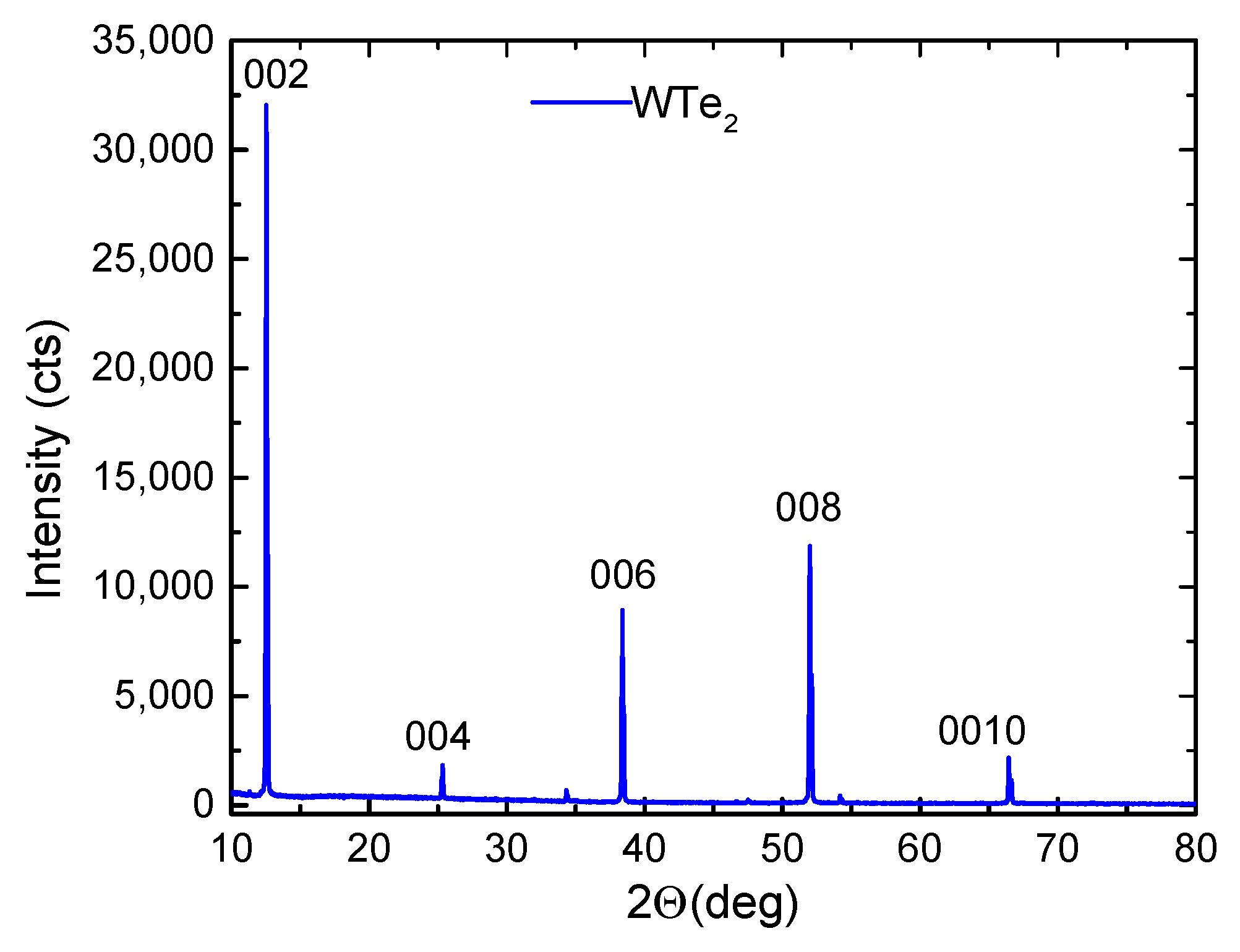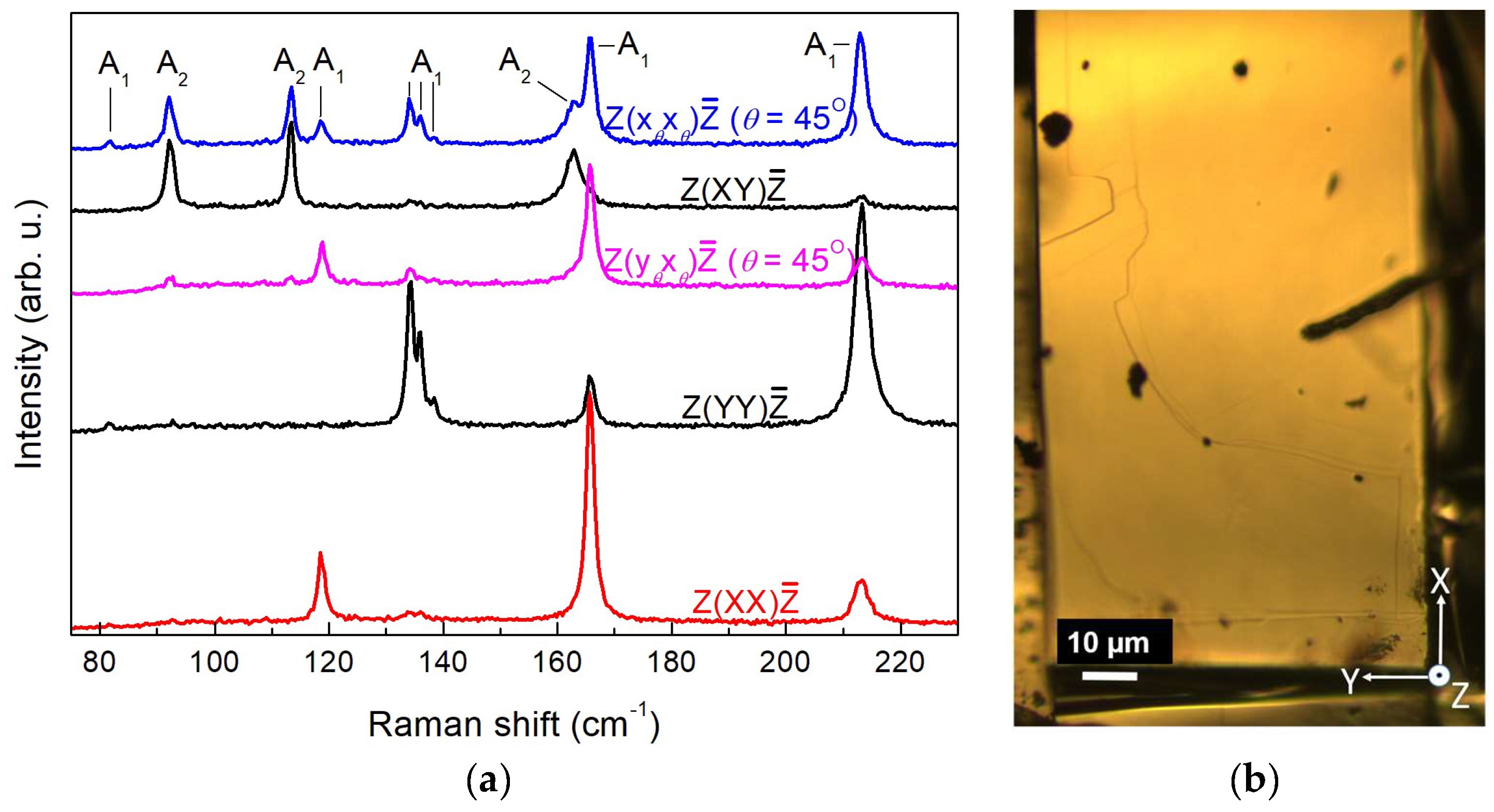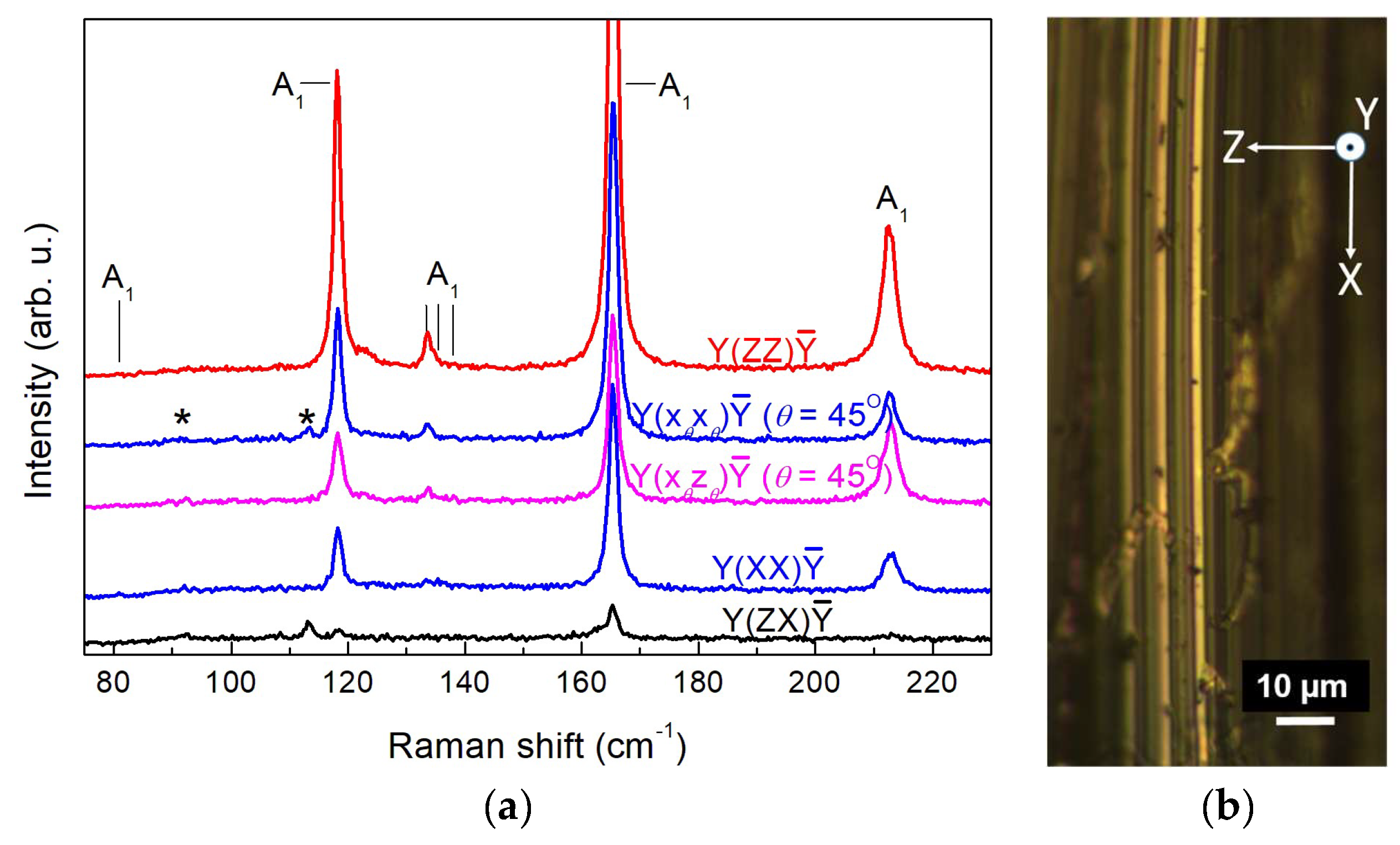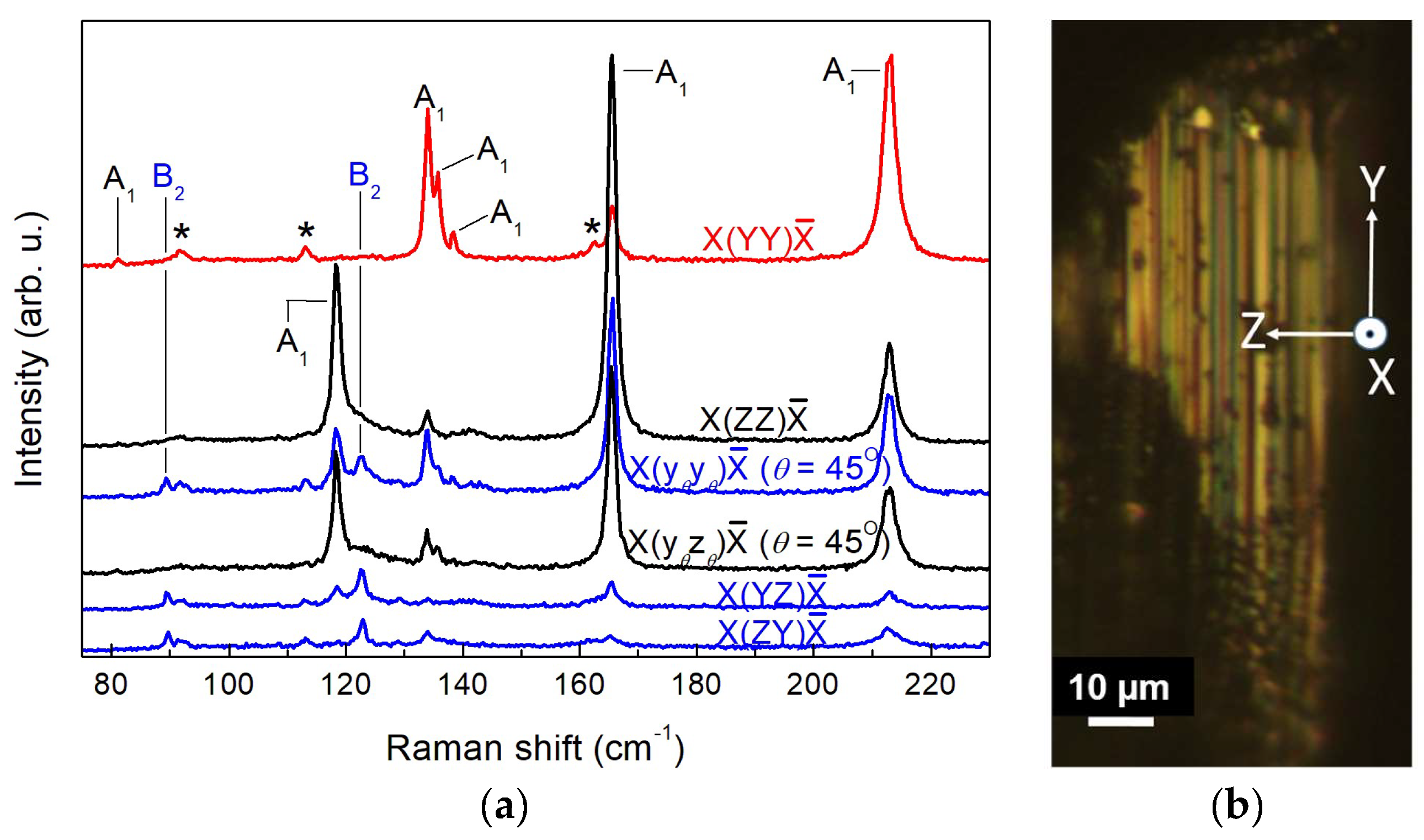Polarized Raman Study of First-Order Phonons in Self-Flux Grown Single-Crystalline WTe2
Abstract
:1. Introduction
2. Materials and Methods
3. Results
3.1. X-ray Diffraction Analysis
3.2. Raman Analysis
4. Conclusions
Author Contributions
Funding
Data Availability Statement
Conflicts of Interest
References
- Novoselov, K.S.; Jiang, D.; Schedin, F.; Booth, T.J.; Khotkevich, V.V.; Morozov, S.V.; Geim, A.K. Two-dimensional atomic crystals. Proc. Natl. Acad. Sci. USA 2005, 102, 10451–10453. [Google Scholar] [CrossRef]
- Ali, M.N.; Xiong, J.; Flynn, S.; Tao, J.; Gibson, Q.D.; Schoop, L.M.; Liang, T.; Haldolaarachchige, N.; Hirschberger, M.; Ong, N.P.; et al. Large, non-saturating magnetoresistance in WTe2. Nature 2014, 514, 205–208. [Google Scholar] [CrossRef] [PubMed]
- Lv, B.Q.; Xu, N.; Weng, H.M.; Ma, J.Z.; Richard, P.; Huang, X.C.; Zhao, L.X.; Chen, G.F.; Matt, C.E.; Bisti, F.; et al. Observation of Weyl nodes in TaAs. Nat. Phys. 2015, 11, 724–727. [Google Scholar] [CrossRef]
- Qian, X.; Liu, J.; Fu, L.; Li, J. Quantum spin Hall effect in two-dimensional transition metal dichalcogenides. Science 2014, 346, 1344–1347. [Google Scholar] [CrossRef] [PubMed]
- Das, P.K.; Di Sante, D.; Cilento, F.; Bigi, C.; Kopic, D.; Soranzio, D.; Sterzi, A.; Krieger, J.A.; Vobornik, I.; Fujii, J.; et al. Electronic properties of candidate type-II Weyl semimetal WTe2. A review perspective. Electron. Struct. 2019, 1, 014003. [Google Scholar] [CrossRef]
- Chhowalla, M.; Shin, H.S.; Eda, G.; Li, L.-J.; Loh, K.P.; Zhang, H. The chemistry of two-dimensional layered transition metal dichalcogenide nanosheets. Nat. Chem. 2013, 5, 263–275. [Google Scholar] [CrossRef] [PubMed]
- Soluyanov, A.A.; Gresch, D.; Wang, Z.; Wu, Q.; Troyer, M.; Dai, X.; Bernevig, B.A. Type-II Weyl Semimetals. Nature 2015, 527, 495. [Google Scholar] [CrossRef] [PubMed]
- Zhao, Y.; Liu, H.; Yan, J.; An, W.; Liu, J.; Zhang, X.; Wang, H.; Liu, Y.; Jiang, H.; Li, Q.; et al. Anisotropic magnetotransport and exotic longitudinal linear magnetoresistance in WTe2 crystals. Phys. Rev. B 2015, 92, 041104(R). [Google Scholar] [CrossRef]
- Huang, C.; Narayan, A.; Zhang, E.; Liu, Y.; Yan, X.; Wang, J.; Zhang, C.; Wang, W.; Zhou, T.; Yi, C.; et al. Inducing strong superconductivity in WTe2 by a proximity effect. ACS Nano 2018, 12, 7185–7196. [Google Scholar] [CrossRef] [PubMed]
- Xu, M.; Tang, B.; Lu, Y.; Zhu, C.; Lu, Q.; Zhu, C.; Zheng, L.; Zhang, J.; Han, N.; Fang, W.; et al. Machine learning driven synthesis of few-layered WTe2 with geometrical control. J. Am. Chem. Soc. 2021, 143, 18103–18113. [Google Scholar] [CrossRef] [PubMed]
- Snure, M.; Motala, M.J.; Prusnick, T.A.; Smith, E.M.; Moore, D.; Muratore, C.; Vangala, S.R.; Glavin, N.R. Two step synthesis of ultrathin transition metal tellurides. J. Vac. Sci. Technol. A 2022, 40, 042202. [Google Scholar] [CrossRef]
- Rhodes, D.; Chenet, D.A.; Janicek, B.E.; Nyby, C.; Lin, Y.; Jin, W.; Edelberg, D.; Mannebach, E.; Finney, N.; Antony, A.; et al. Engineering the Structural and Electronic Phases of MoTe2 through W Substitution. Nano Lett. 2017, 17, 1616–1622. [Google Scholar] [CrossRef] [PubMed]
- Buchkov, K.; Todorov, R.; Terziyska, P.; Gospodinov, M.; Strijkova, V.; Dimitrov, D.; Marinova, V. Anisotropic Optical Re-sponse of WTe2 Single Crystals Studied by Ellipsometric Analysis. Nanomaterials 2021, 11, 2262. [Google Scholar] [CrossRef] [PubMed]
- Ali, M.N.; Schoop, L.; Xiong, J.; Flynn, S.; Gibson, Q.; Hirschberger, M.; Ong, N.P.; Cava, R.J. Correlation of crystal quality and extreme magnetoresistance of WTe2. Europhys. Lett. 2015, 110, 67002. [Google Scholar] [CrossRef]
- Mangelsen, S.; Bensch, W. HfTe2: Enhancing Magnetoresistance Properties by Improvement of the Crystal Growth Method. Inorg. Chem. 2020, 59, 1117–1124. [Google Scholar] [CrossRef] [PubMed]
- Marinova, V.; Minev, N.; Napoleonov, B.; Karashanova, D.; Rafailov, P.; Kovacheva, D.; Strijkova, V.; Ranguelov, B.; Mussi, V.; Fuscaldo, W.; et al. PdSe2 single crystals synthesized by the self-flux method. J. Cryst. Growth 2024, 643, 127812. [Google Scholar] [CrossRef]
- Liu, S.; Liu, Y.; Holtzman, L.; Li, B.; Holbrook, M.; Pack, J.; Taniguchi, T.; Watanabe, K.; Dean, C.R.; Pasupathy, A.N.; et al. Two-step flux synthesis of ultrapure transition metal dichalcogenides. ACS Nano 2023, 17, 16587–16596. [Google Scholar] [CrossRef] [PubMed]
- Edelberg, D.; Rhodes, D.; Kerelsky, A.; Kim, B.; Wang, J.; Zangiabadi, A.; Kim, C.; Abhinandan, A.; Ardelean, J.; Scully, M.; et al. Approaching the Intrinsic Limit in Transition Metal Diselenides via Point Defect Control. Nano Lett. 2019, 19, 4371–4379. [Google Scholar] [CrossRef] [PubMed]
- Lee, C.H.; Silva, E.C.; Calderin, L.; Nguyen, M.A.T.; Hollander, M.J.; Bersch, B.; Mallouk, T.E.; Robinson, J.A. Tungsten Ditelluride: A layered semimetal. Sci. Rep. 2015, 5, 10013. [Google Scholar] [CrossRef]
- Jiang, Y.C.; Gao, J.; Wang, L. Raman fingerprint for semi-metal WTe2 evolving from bulk to monolayer. Sci. Rep. 2016, 6, 196244. [Google Scholar] [CrossRef] [PubMed]
- Song, Q.; Pan, X.; Wang, H.; Zhang, K.; Tan, Q.; Li, P.; Wan, Y.; Wang, Y.; Xu, X.; Lin, M.; et al. The In-Plane Anisotropy of WTe2 Investigated by Angle-Dependent and Polarized Raman Spectroscopy. Sci. Rep. 2016, 6, 29254. [Google Scholar] [CrossRef] [PubMed]
- Kong, W.D.; Wu, S.F.; Richard, P.; Lian, C.S.; Wang, J.T.; Yang, C.L.; Shi, Y.G.; Ding, H. Raman scattering investigation of large positive magnetoresistance material WTe2. Appl. Phys. Lett. 2022, 6, 022001. [Google Scholar] [CrossRef]
- Kim, M.; Han, S.; Kim, J.H.; Lee, J.U.; Lee, Z.; Cheong, H. Determination of the thickness and orientation of few-layer tungsten ditelluride using polarized Raman spectroscopy. 2D Mater. 2016, 3, 034004. [Google Scholar] [CrossRef]
- Ma, X.; Guo, P.; Yi, C.; Yu, Q.; Zhang, A.; Ji, J.; Tian, Y.; Jin, F.; Wang, Y.; Liu, K.; et al. Raman scattering in the transition-metal dichalcogenides of 1T-MoTe2, Td-MoTe2, and Td-WTe2. Phys. Rev. B 2016, 94, 214105. [Google Scholar] [CrossRef]
- Cao, Y.; Sheremetyeva, N.; Liang, L.; Yuan, H.; Zhong, T.; Meunier, V.; Pan, M. Anomalous vibrational modes in few layer WTe2 revealed by polarized Raman scattering and first-principles calculations. 2D Mater. 2017, 4, 035024. [Google Scholar] [CrossRef]
- Camosi, L.; Světlík, J.; Costache, M.V.; Torres, W.S.; Aguirre, I.F.; Marinova, V.; Dimitrov, D.; Gospodinov, M.; Sierra, J.F.; Valenzuela, S.O. Resolving spin currents and spin densities generated by charge-spin interconversion in systems with reduced crystal symmetry. 2D Mater. 2022, 9, 035014. [Google Scholar] [CrossRef]
- Brown, B. The crystal structures of WTe2 and high-temperature MoTe2. Acta Crysta. 1966, 20, 268–274. [Google Scholar] [CrossRef]
- Mar, A.; Jobic, S.; Ibers, J.A. Metal-metal vs tellurium-tellurium bonding in WTe2 and its ternary variants TaIrTe4 and NbIrTe4. J. Am. Chem. Soc. 1992, 114, 8963–8971. [Google Scholar] [CrossRef]
- Kabashima, S. Electrical Properties of Tungsten-Ditelluride WTe2. J. Phys. Soc. Jpn. 1966, 21, 945–948. [Google Scholar] [CrossRef]
- Rafailov, P.M.; Dimitrov, D.Z.; Chen, Y.-F.; Lee, C.-S.; Juang, J.-Y. Symmetry of the Optical Phonons in LuVO4: A Raman Study. Crystals 2020, 10, 341. [Google Scholar] [CrossRef]
- Cardona, M.; Güntherodt, G. (Eds.) Light Scattering in Solids II; Springer: Berlin/Heidelberg, Germany, 1982; Volume 50, Chapter 2; pp. 19–178. [Google Scholar]
- Saito, R.; Tatsumi, Y.; Huang, S.; Ling, X.; Dresselhaus, M.S. Raman Spectroscopy of Transition Metal Dichalcogenides. J. Phys. Condens. Matter 2016, 28, 353002. [Google Scholar] [CrossRef] [PubMed]
- Ding, Y.; Zheng, W.; Zhu, Y.; Jin, M.; Lin, Z.; Zhu, R.; Huang, F. Raman Tensor of Layered Td-WTe2. J. Phys. Chem. C 2020, 124, 16596–16603. [Google Scholar] [CrossRef]
- Strach, T.; Brunen, J.; Lederle, B.; Zegenhagen, J.; Cardona, M. Determination of the phase difference between the Raman tensor elements of the A1g-like phonons in SmBa2Cu3O7−δ. Phys. Rev. B 1998, 57, 1292–1297. [Google Scholar] [CrossRef]






| Mode Symmetry | Z(xθxθ) (XX→YY) | Z(xθyθ) (XY→YX) | Y(xθxθ) (XX→ZZ) | Y(xθzθ) (XZ→ZX) |
|---|---|---|---|---|
| A1 | |a·cos2θ + b·sin2θ|2 | (|a − b|2/4)·sin22θ | |a·cos2θ + c·sin2θ|2 | (|a − c|2/4)·sin22θ |
| A2 | |d|2·sin22θ | |d|2·cos22θ | 0 | 0 |
| B1 | 0 | 0 | |e|2·sin22θ | |e|2·cos22θ |
| B2 | 0 | 0 | 0 | 0 |
| Mode Symmetry | X(yθyθ) (YY→ZZ) | X(yθzθ) (YZ→ZY) | ||
| A1 | |b·cos2θ + c·sin2θ|2 | (|b − c|2/4)·sin22θ | ||
| A2 | 0 | 0 | ||
| B1 | 0 | 0 | ||
| B2 | |f|2·sin22θ | |f|2·cos22θ |
| Experimental Frequency (cm−1) | 80 | 118 | 133 | 135 | 137.5 | 165 | 212 |
| Full width at half maximum (cm−1) | 1.5 | 1.5 | 1.5 | 1.5 | 1.5 | 1.8 | 2.7 |
| Ratio of magnitudes of Raman tensor elements |a|:|b|:|c| | 1.5 : 2 : 1 | 6 : 1 : 13 | 1 : 4 : 2 | 1.5 : 5 : 1 | 1 : 3 : 1.5 | 2.5 : 1 : 4 | 1 : 3 : 2 |
| cos ϕab | 1 | −1 | 1 | 1 | 0.3 | 0.3 | 0.9 |
| cos ϕac | −0.3 | 0.5 | 0.3 | 0 | −0.5 | 0.5 | −0.2 |
| cos ϕbc | −0.3 | −0.5 * | 0.3 | 0 | 0.7 | −0.7 | 0.2 |
Disclaimer/Publisher’s Note: The statements, opinions and data contained in all publications are solely those of the individual author(s) and contributor(s) and not of MDPI and/or the editor(s). MDPI and/or the editor(s) disclaim responsibility for any injury to people or property resulting from any ideas, methods, instructions or products referred to in the content. |
© 2024 by the authors. Licensee MDPI, Basel, Switzerland. This article is an open access article distributed under the terms and conditions of the Creative Commons Attribution (CC BY) license (https://creativecommons.org/licenses/by/4.0/).
Share and Cite
Rafailov, P.M.; Dimitrov, D.; Kovacheva, D.; Marinova, V. Polarized Raman Study of First-Order Phonons in Self-Flux Grown Single-Crystalline WTe2. Nanomaterials 2024, 14, 1256. https://doi.org/10.3390/nano14151256
Rafailov PM, Dimitrov D, Kovacheva D, Marinova V. Polarized Raman Study of First-Order Phonons in Self-Flux Grown Single-Crystalline WTe2. Nanomaterials. 2024; 14(15):1256. https://doi.org/10.3390/nano14151256
Chicago/Turabian StyleRafailov, Peter M., Dimitre Dimitrov, Daniela Kovacheva, and Vera Marinova. 2024. "Polarized Raman Study of First-Order Phonons in Self-Flux Grown Single-Crystalline WTe2" Nanomaterials 14, no. 15: 1256. https://doi.org/10.3390/nano14151256







